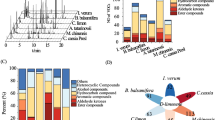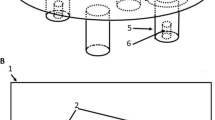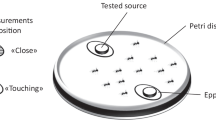Abstract
Red imported fire ants, Solenopsis invicta, are significant invasive pests. Certain native ant species can compete with S. invicta, such as the little black ant, Monomorium minimum. Defensive secretions may contribute to the competition capacity of native ants. The chemistry of ant defensive secretions in the genus Monomorium has been subjected to extensive research. The insecticidal alkaloids, 2,5-dialkyl-pyrrolidines and 2,5-dialkyl-pyrrolines have been reported to dominate the venom of M. minimum. In this study, analysis of defensive secretions of workers and queens of M. minimum revealed two primary amines, decylamine and dodecylamine. Neither amine has been reported previously from natural sources. Toxicity and digging suppression by these two amines against S. invicta were examined. Decylamine had higher toxicity to S. invicta workers than dodecylamine, a quicker knockdown effect, and suppressed the digging behavior of S. invicta workers at lower concentration. However, the amount of fatty amines in an individual ant was not enough to knockdown a fire ant or suppress its digging behavior. These amines most likely work in concert with other components in the chemical defense of M. minimum.



Similar content being viewed by others
References
Adam ES, Traniello JFA (1981) Chemical interference competition by Monomorium minimum (Hymenoptera: Formicidae). Oecologia 51:265–270
Allen CR, Epperson DM, Garmestani AS (2004) Red imported fire ant impacts on wildlife: a decade of research. Am Midl Nat 152:88–103
Andersen AN, Blum MS, Jones TH (1991) Venom alkaloids in Monomorium ‘rothsteini’ Forel repel other ants: is this the secret to success by Monomorium in Australian ant communities. Oecologia 88:157–160
Ascunce MS, Yang CC, Oakey J, Calcaterra L, Wu WJ, Shih CJ, Goudet J, Ross KG, Shoemaker D (2011) Global invasion history of the fire ant Solenopsis invicta. Science 331:1066–1068
Atkins EL, Macdonald RL, Greywood-Hale EA (1975) Repellent additives to reduce pesticide hazards to honey bees: field tests. Environ Entomol 4:207–210
Attygalle AB, Kern F, Huang Q, Meinwald J (1998) Trail pheromone of the myrmicine ant Aphaenogaster rudis (Hymenoptera: Formicidae). Naturwissenschaften 85:38–41
Bacos D, Basselier JJ, Celerier JP, Lange C, Marx E, Lhommet G, Escoubas P, Lemaire M, Clément JL (1988) Ant venom alkaloids from Monomorium species: natural insecticides. Tetrahedron Lett 29:3061–3064
Baroni Urbani C, Kannowski PB (1974) Patterns in the red imported fire ant settlement of a Louisiana pasture: some demographic parameters, interspecific competition and food sharing. Environ Entomol 3:755–760
Binder BF, Robbins JC (1997) Effect of terpenoids and related compounds on the oviposition behavior of the European corn borer, Ostrinia nubilalis (Lepidoptera: Pyralidae). J Agric Food Chem 45:980–984
Buhlmann KA, Coffman G (2001) Fire ant predation of turtle nests and implications for the strategy of delayed emergence. J Elisha Mitchell Sci Soc 117:94–100
Caro MR, Derbes VJ, Jung R (1957) Skin responses to the sting of the imported fire ant (Solenopsis saevissima). Arch Dermatol 75:475–488
Chen J (2009) Repellency of an over-the-counter essential oil product from China against workers of red imported fire ants. J Agric Food Chem 57:618–622
Cook JL (2003) Conservation of biodiversity in an area impacted by the red imported fire ant, Solenopsis invicta (Hymenoptera: Formicidae). Biodivers Conserv 12:187–195
deShazo RD, Griffing C, Kwan TH, Banks WA, Dvorak HF (1984) Dermal hypersensitivity reactions to imported fire ants. J Allergy Clin Immunol 74:841–847
Evershed RP, Morgan ED, Cammaerts MC (1982) 3-ethyl-2,5-dimethylpyrazine, the trail pheromone from the venom gland of eight species of Myrmica ants. Insect Biochem 12:383–391
Fales HM, Blum MS, Bian Z, Jones TH, Don AW (1984) Volatile compounds from ponerine ants in the genus Mesoponera. J Chem Ecol 10:651–665
Helms KR, Vinson SB (2001) Coexistence of native ants with the red imported fire ant, Solenopsis invicta. Southwest Nat 46:396–399
James FK Jr, Pence HL, Driggers DP, Jacobs RL, Horton DE (1976) Imported fire ant hypersensitivity: studies of human reactions to fire ant venom. J Allergy Clin Immunol 58:110–120
Jones TH, Blum MS, Howard RW, McDaniel CA, Fales HM, DuBois MB, Torres J (1982) Venom chemistry of ants in the genus Monomorium. J Chem Ecol 8:285–300
Jones TH, Blum MS, Andersen AN, Fales HM, Escoubas P (1988) Novel 2-ethyl-5-alkylpyrrolidines in the venom of an Australian ant of the genus Monomorium. J Chem Ecol 14:35–45
Jones TH, Blum MS, Escoubas P, Musthak Ali TM (1989) Novel pyrrolidines in the venom of the ant Monomorium indicum. J Nat Prod 52:779–784
Jones TH, Torres JA, Snelling RR, Spande TF (1996) Primary tetradecenyl amines from the ant Monomorium floricola. J Nat Prod 59:801–802
Jones TH, Clark DA, Heterick BE, Snelling RR (2003) Farnesylamine from the ant Monomorium fieldi Forel. J Nat Prod 66:325–326
Jones TH, Andersen AN, Kenny JC (2009) Venom alkaloid chemistry of Australian species of the Monomorium rothsteini complex, with particular reference to taxonomic implications. Chem Biodivers 6:1034–1041
Kopachena JG, Buckley AJ, Potts GA (2000) Effects of the red imported fire ant (Solenopsis invicta) on reproductive success of barn swallows (Hirundo rustica) in northeast Texas. Southwest Nat 45:477–482
Lange C, Celerier JP, Lhommet G, Basselier JJ, Lemaire M, Escoubas P, Clément JL (1989) Analysis of worker Monomorium minimum ant’s venom using gas chromatography/mass spectrometry and gas chromatography/tandem mass spectrometry. Biomed Environ Mass Spectrom 18:780–786
Langkilde T, Freidenfelds NA (2010) Consequences of envenomation: red imported fire ants have delayed effects on survival but not growth of native fence lizards. Wildl Res 37:566–573
Leclercq S, Braekman JC, Daloze D, Pasteels JM (2000) The defensive chemistry of ants. Prog Chem Org Nat Prod 79:115–229
Lockey RF (1974) Systemic reactions to stinging ants. J Allergy Clin Immunol 54:132–146
Lowe S, Browne M, Boudjelas S, De Poorter M (2004) 100 of the world’s worst invasive alien species. A selection from the global invasive species database. Published by The Invasive Species Specialist Group (ISSG) a specialist group of the Species Survival Commission (SSC) of the World Conservation Union (IUCN), 12 p
MacConnell JG, Blum MS, Fales HM (1971) The chemistry of fire ant venom. Tetrahedron 27:1129–1139
Morgan ED (1990) Exocrine gland chemistry and phylogeny of ants. In: Veeresh GK, Mallik B, Viraktamath CA (eds) Social insects and the environment. Proceedings of the 11th International Congress of IUSSI, 1990. Oxford & IBH Publishing Co., New Delhi. p 319–320. xxxi + 765 p
Morrison LW, Porter SD, Daniels E, Korzukhin MD (2004) Potential global range expansion of the invasive fire ant, Solenopsis invicta. Biol Invasions 6:183–191
Morrison LW, Korzukhin MD, Porter SD (2005) Predicted range expansion of the invasive fire ant, Solenopsis invicta, in the eastern United States based on the VEMAP global warming scenario. Divers Distrib 11:199–204
Nagase A, Kuwahara Y, Tominaga Y, Sugawara R (1982) Nematicidal activity of akylamine against the pine wood nematode, Bursaphelenchus lignicolus. Agric Biol Chem 46:167–172
Pedersen EK, Bedford TL, Grant WE, Vinson SB, Martin JB, Longnecker MT, Barr CL, Drees BM (2003) Effect of red imported fire ants on habitat use by hispid cotton rats (Sigmodon hispidus) and northern pygmy mice (Baiomys taylori). Southwest Nat 48:419–426
Porter SD, Savignano DA (1990) Invasion of polygyne fire ants decimates native ants and disrupts arthropod community. Ecology 71:2095–2106
Ralston AW, Barrett JP (1941) Insect repellent activity of fatty acid derivative. Oil & Soap 18:89–91
Rao A, Vinson SB (2004) Ability of resident ants to destruct small colonies of Solenopsis invicta (Hymenoptera: Formicidae). Environ Entomol 33:587–598
Rao A, Vinson SB (2007) Interactions between Solenopsis invicta (Buren) and Monomorium minimum (Buckley) under varying distance and feeding status. Southwest Entomol 32:111–125
Ross KG, Vander Meer RK, Fletcher DJC, Vargo EL (1987) Biochemical phenotypic and genetic studies of two introduced fire ants and their hybrid (Hymenoptera: Formicidae). Evolution 41:280–293
Smith MR (1965) House-infesting ants of the eastern United States. Their recognition, biology, and economic importance. United States Department of Agriculture, Technical Bulletin 1326: ii, 105 p
Sorensen AA, Trostle M (1986) Control of fire ants inside barns, livestock enclosures or poultry houses. Texas Department of Agriculture, Fire Ant Project Brochure 6, 4 p
Thompson CR (1990) Ants that have pest status in the United States. In: Vander Meer RK, Jaffe K, Cedeno A (eds) Applied myrmecology: a world perspective. Westview Press, Boulder, pp 51–67, 741 p
Vinson SB (1997) Invasion of the red imported fire ant (Hymenoptera: Formicidae): spread, biology, and impact. Am Entomol 43:23–39
Vinson SB (2013) Impact of the invasion of the imported fire ant. Insect Sci 20:439–455
Wang L, Lu YY, Xu YJ, Zeng L (2013) The current status of research on Solenopsis invicta Buren (Hymenoptera: Formicidae) in Mainland China. Asian Myrmecol 5:125–138
Yamamoto T, Tanada Y (1980) Acylamine enhance the infection of a Baculovirus of the Armyworm, Pseudaletia unipuncta (Noctuidae, Lepidoptera). J Invertebr Pathol 35:265–268
Acknowledgments
We thank Dr. Tahir Rashid, Alcorn State University, Extension/Research Demonstration Farm & Technology Transfer Center, Mound Bayou, MS and Dr. Bal K. Gautam, Department of Entomology, University of Georgia, Athens, GA for critical reviews of the manuscript. We thank Mr. Leon Hicks for technical assistance. We declare that no conflicts of interests exist. Mention of trade names or commercial products in this publication is solely for the purpose of providing specific information and does not imply recommendation or endorsement by the U. S. Department of Agriculture. This project is supported by the Hesheng Zhujiang Education Foundation from South China Agricultural University and Chinese and State Scholarship Fund from China Scholarship Council.
Author information
Authors and Affiliations
Corresponding author
Rights and permissions
About this article
Cite this article
Wang, L., Chen, J. Fatty Amines from Little Black Ants, Monomorium minimum, and Their Biological Activities Against Red Imported Fire Ants, Solenopsis invicta . J Chem Ecol 41, 708–715 (2015). https://doi.org/10.1007/s10886-015-0609-3
Received:
Revised:
Accepted:
Published:
Issue Date:
DOI: https://doi.org/10.1007/s10886-015-0609-3




